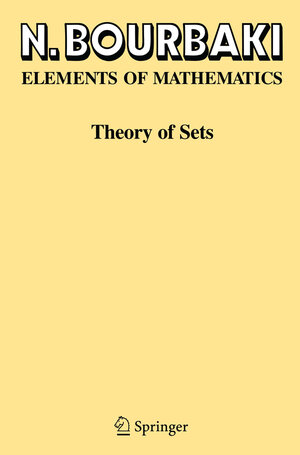
×
![Buchcover ISBN 9783642593093]()
Theory of Sets
von N. BourbakiInhaltsverzeichnis
- I. Description of Formal Mathematics.
- § 1. Terms and relations.
- § 2. Theorems.
- § 3. Logical theories.
- § 4. Quantified theories.
- § 5. Equalitarian theories.
- Appendix. Characterization of terms and relations.
- Exercises for § 1.
- Exercises for § 2.
- Exercises for § 3.
- Exercises for § 4.
- Exercises for § 5.
- Exercises for the Appendix.
- II. Theory of Sets.
- § 1. Collectivizing relations.
- § 2. Ordered pairs.
- § 3. Correspondences.
- § 4. Union and intersection of a family of sets.
- § 5. Product of a family of sets.
- § 6. Equivalence relations.
- Exercises for § 6.
- III. Ordered Sets, Cardinals, Integers.
- § 1. Order relations. Ordered sets.
- § 2. Well-ordered sets.
- § 3. Equipotent sets. Cardinals.
- § 4. Natural integers. Finite sets.
- § 5. Properties of integers.
- § 6. Infinite sets.
- § 7. Inverse limits and direct limits.
- Exercises for § 7.
- Historical Note on § 5.
- IV. Structures.
- § 1. Structures and isomorphisms.
- § 2. Morphisms and derived structures.
- § 3. Universal mappings.
- Historical Note on Chapters I-IV.
- Summary of Results.
- § 1. Elements and subsets of a set.
- § 2. Functions.
- § 3. Products of sets.
- § 4. Union, intersection, product of a family of sets.
- § 5. Equivalence relations and quotient sets.
- § 6. Ordered sets.
- § 7. Powers. Countable sets.
- § 8. Scales of sets. Structures.
- Index of notation.
- Index of terminology.
- Axioms and schemes of the theory of sets.



